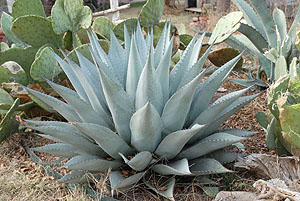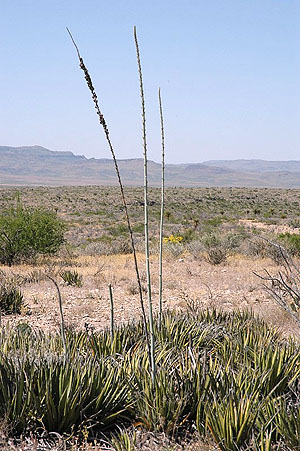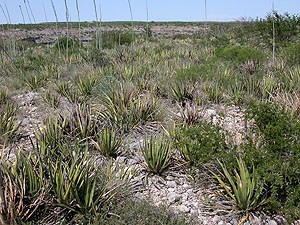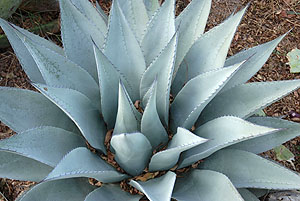Havard Agave, Lechuguilla, New Mexico Agave
Agave havardiana Trel.; Agave lechuguilla Torr.; Agave neomexicana Woot. & Standl.
Three Trans-Pecos agave species have a deep history of use by Native Americans, the Havard agave, lechuguilla, and the New Mexico agave. They are both abundant and widespread across the region. Agave is also generically referred to as mescal (Buskirk 1986). The agaves were undoubtedly among the most important plants to the native peoples of the Trans-Pecos and elsewhere across the southern American Southwest and in northern Mexico. They provided a critical food staple and were also used for beverage, weaving, and more. The utility of agave was best expressed by Bourke (1891:10), who noted that “. . . the crown of the mescal provided food, the juice was fermented into a drink, the thorn with its adhering filament served as needle and thread, the stalk was used for a lance shaft, and even a “fiddle” was fashioned from the stalk”.
The Havard and the New Mexico agaves are fairly large, with leaves measuring up to 70 cm and a total body size of about 1.5-2 meters. In contrast, the lechuguilla is small, with leaves usually reaching 30 cm and a width of less than 50 cm. The Havard agave is common in the eastern mountains of the Trans-Pecos, particularly the Davis, Glass, and Chisos mountains, although its range includes the Guadalupes and northern Mexico. The New Mexico agave is somewhat restricted to the western side of the Trans-Pecos, and as the name implies, its range includes New Mexico. Lechuguilla is a small agave that is widespread across lower rocky slopes of mountains and hillsides across most of the region. Almost every part of an agave was utilized in some manner, either for food, medicine, building material, clothing, or implements (Gentry 1982; Powell 1998).
Agaves are evergreen rosettes, that is, the leaves are arranged in ranks around a thick, pulpy stem. Food is stored in this stem, protected by the thick, cuticle covered leaves that have spines on the margins and tips to discourage would-be grazers or predators. Another discouragement is the fact that the carbohydrates are chemically bonded to sapogenins to form a saponin. When shaken with water, saponins have a characteristic foamy reaction, and can be used as a surfactant, emulsifier, or for soap. Steroidal saponins, the kind prevalent in agaves, are very bioactive and can cause severe reactions when exposed to animal tissue, not the kind of food one wants to consume. Native Americans, however, had a technological innovation that split the carbohydrate from the offending steroids. That innovation is the earth oven. By baking the agaves for 2 days in an earth oven, the combination of heat and moisture turn a toxic plant into a mass of molasses flavored sugars.
Archeology. Agave leaf fragments, stalks, and fibers have been recovered from a wide variety of archeological contexts. Fragments of lechuguilla occur by the thousands in the cave and rockshelter deposits of the eastern Trans-Pecos region. (And adjacent Lower Pecos Canyonlands, see Lechuguilla.) Agave fiber and leaf fragments have been recovered from numerous sites in the Jornada Mogollon region of El Paso County. In this region, agave use was widespread until dependence on agriculture reduced its demand during the latter part of the Late Prehistoric period.
Food. The Mescalero Apache baked the central stems in pits and dried and stored them. The agave is collected and the leaves are trimmed just above the bases. Buskirk (1986:170) notes that an unhafted chert blade was used for this purpose before steel was available. The pits for cooking the larger agaves were probably 3-4 meters in diameter and one meter deep. Wood is piled into the pit with rocks placed within and on top of the stack. The heat transfers from the burning wood to the rocks, which constitute the heating element of the oven. Once the fire has died and the rocks are glowing hot, they are lined with green plant material. This provides the steam that drives the hydrolytic reactions that convert the inedible compounds inside the agave stem to edible sugars. A variety of plant materials were used, and Castetter and Opler (1936) list big bluestem, sideoats grama, bunch grass, and bear grass among others. In the eastern Trans-Pecos evidence from rockshelters suggests that prickly pear pads were utilized to line the rocks, and they serve this purpose quite well. The stems are placed on the steaming plant material and covered with a mat, a hide, or plant material such as beargrass leaves, and then the pit is sealed with earth. Castetter and Opler (1936) note that the Indians would place cattail pollen on the largest crown in the shape of a cross oriented east-west and north-south, and then pray.
The baked stems or crowns are removed from the oven two days later, and the leaf bases are removed. They pound the pulpy material into large sheets resembling flat cakes that are set out in the sun to dry on mats known as agave cradles. The dried sheets were staked and tied with beargrass (Buskirk 1986). The dried central stems were also were processed into a meal or flour and added to food (Basehart 1960).
The emerging agave flower stalks were collected in the spring. The stalks, which resemble large asparagus, were usually cooked on hot coals for a short time and eaten. They are best taken long before they begin to flower, as they very quickly become too fibrous to consume. Today in northern San Luis Potosi, Mexico agave flower stalks are cooked and sold for candy on the roadside.
Most of the Southwestern species of agave can be baked and eaten in any season (see Buskirk 1986:169; Castetter et al. 1938:46). In practice the actual season varied from group to group, territory to territory, and even year to year. However, it is likely that in average years, agave was harvested and processed during the winter/spring months. For example, although it was available year-round, the Kaibab used agave in the winter and spring when food was short (Castetter et al. 1938:46).
Speaking generally of the Western Apache, Buskirk (1986:170) indicates that the best time for gathering was early spring or April. However, when preferred foods were in short supply agave was collected in the fall or winter. In the low to middle elevations of the Chihuahuan Desert and adjacent areas, agave was probably harvested and processed in the cool season, primarily early spring. During winter and early spring, there are few seeds and fruits available for consumption, and groups would turn to a carbohydrate source that is available year round. Agave would have been the ideal source.
Beverages. The Mescalero prepared fermented beverages from baked agave stems. After cooking in pits for two days, the central stem is pulpy and sweet. My experience with lechuguilla is that the cooked material is so sugary that it must be pounded into cakes and dried quickly or it will start to ferment within 24 hours. I once made the mistake of leaving the cooked stems in a garbage bag for five days. On the fifth day I found that the stems had fermented and soured, and the resulting liquid had eaten through the plastic bag, etching the tile on the floor of my laboratory.
The Mescalero, however, were not so wasteful. They cut the cooked pulp into pieces and buried it in an animal hide pouch for about two days. Then they exhumed it, pressed the juice into a jar and let it ferment for a few more days (Castetter et al. 1938). Some groups mixed the fermented mescal drink with tiswin, or fermented maize drink and let is stand for five or six days (Buskirk 1986).
Other uses. The cooked crowns could also make a brown paint or stain. The Western Apache used the woody flower stalk for lance shafts and for implement handles (Buskirk 1986). Agave fibers were fashioned into sandals, baskets, nets, and cordage (Castetter et al. 1938). Lechuguilla sandals have been recovered from numerous rockshelters in the eastern Trans-Pecos. Agave was not only a food source, it was a source of implements utilized to obtain food. Traps and snares were fashioned by many groups using agave fiber cordage (Castetter et al. 1938). Thus agave was a critical component of the subsistence system for the Native Americans of the Trans-Pecos region.
References
Basehart, Harry
1960 Mescalero Apache Subsistence Patterns and Socio-Political Organization. The University of New Mexico Mescalero-Chiricahua Land Claims Project Contract Research #290-154. University of New Mexico. Albuquerque.
Bourke, John G.
1891 On the Border with Crook. Charles Scribners Sons. New York.
Buskirk, Winfred
1986 The Western Apache: Living with the Land Before 1950. University of Oklahoma Press, Norman.
Castetter Edward F., and Morris Opler
1936 The Ethnobiology of the Chiricahua and Mescalero Apache: The Use of Plants for Foods, Beverages, and Narcotics. Ethnobiological Studies in the American Southwest. Vol. III. The University of New Mexico Bulletin, Biological Series 4(5), Albuquerque.
Castetter, Edward, Willis H. Bell, and Alvin R. Grove
1938 The Early Utilization and the Distribution of Agave In the American Southwest. Ethnobiological Studies in the American Southwest. Vol. VI. The University of New Mexico Bulletin, Biological Series 5(4). Albuquerque, New Mexico.
Gentry, Howard S.
1982 Agaves of Continental North America. University of Arizona Press. Tucson.
McGregor, Roberta
1992 Prehistoric Basketry of the Lower Pecos, Texas. Monographs in World Archaeology, No. 6. Prehistory Press. Madison, Wisconsin.
Miller, Myles R., and Nancy A. Kenmostu
2004 Prehistory of the Jornada Mogollon and Eastern Trans-Pecos Regions. In The Prehistory of Texas, edited by T.K. Perttula, pp. 205-265. Texas A&M University Press. College Station, Texas.
Powell, A. Michael
1998 Trees and Shrubs of the Trans-Pecos and Adjacent Areas. University of Texas Press. Austin.

|

|

|
